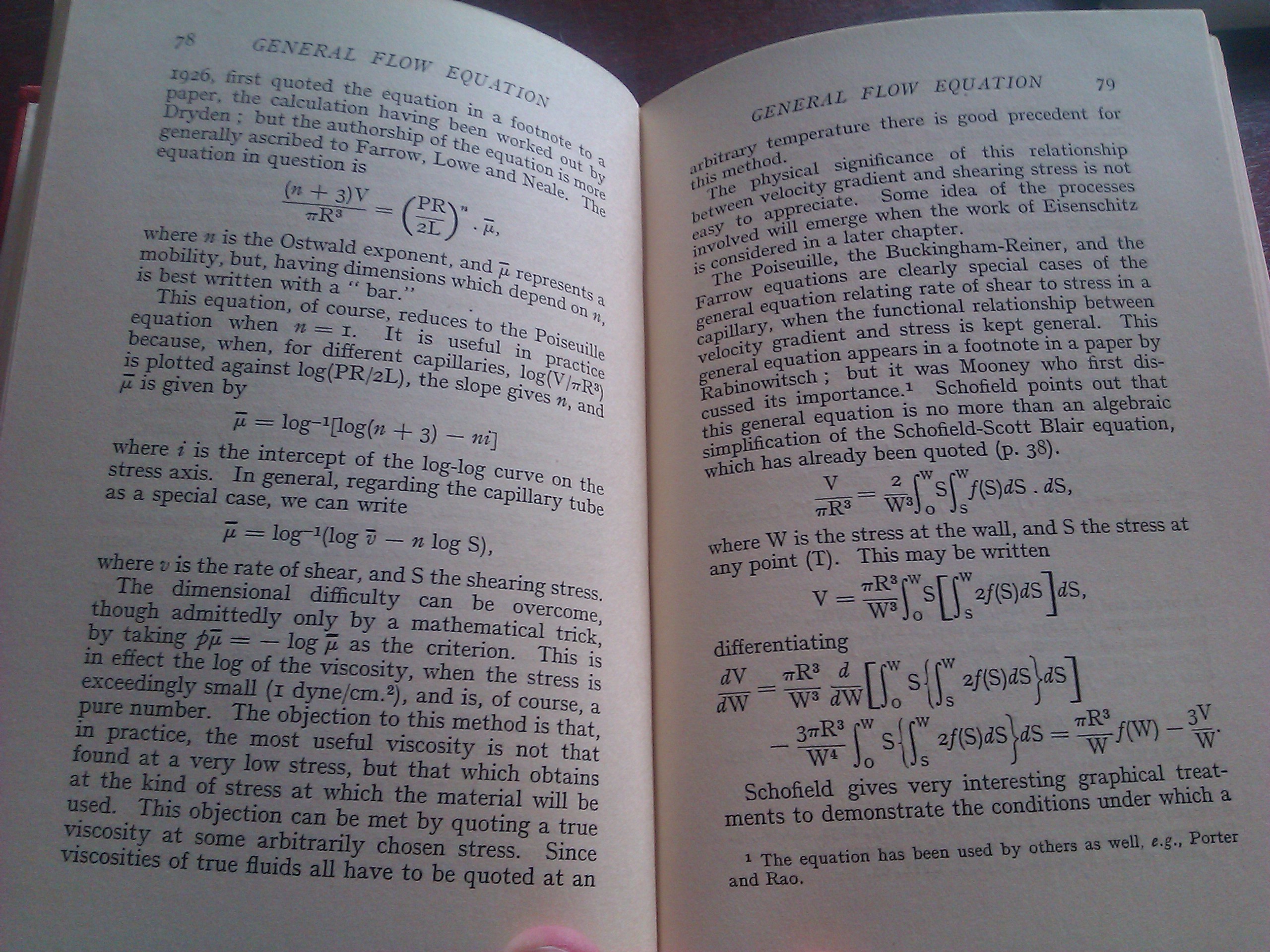str (101)

GE X ERA.
FLOW
paper, the calculation having been Dryden ; but the authorehip of the enJSS J generally ascribed to Farrow, Lowe aJJ&0*1 is
I
LJ
%
where n is the Ostwald exponent, and p repre mobility, but, having dimensions which depe^^1 is best written with a | bar.” . 111‘, I
This eąuation, of course, reduces to the p0ise eąuation when n — i. It is useful in practi because, when, for different capillaries, log| is plotted against log(PR/2L), the slope gives n, and I is given by
I =: log-1 [log(« + 3) ~ Wt]
where i is the intercept of the log-log curve on the stTess axis. In generał, regarding the capillary tubę as a special case, we can wnte
IB log-1 (log | — I log S),
where i is the ratę of shear, and S the shearing stress.
The dimensional difficulty can be overcome, though admittedly only by a mathematical trick, by taking fjl — — log 1 as the criterion. This is in eftect the log of the viscosity, when the stress is exceedingly smali (i dyne/cm.2), and is, of course, a pure number. The objection to this method is that, in practice, the most useful viscosity is not that found at a very Iow stress, but that which obtains at the kind of stress at włńch the materiał will be used. This objection can be met by ąuoting a true viscosity at some arbitrarily chosen stress. Since viscosities of true fluids all have to be ąuoted at an
GENERAL FLOW EQUAT10N 79
rbitrary temperaturę there is good precedent for
^The^p^ysical significance of this relationship betweenvelocity gradient and shearing stress is not eaSy to appreciate. Some idea of the processes involved will emerge when the work of Eisenschitz is considered in a later chapter.
The Poiseuille, the Buckingham-Reiner, and the Farrow eąuations are clearly special cases of the generał eąuation relating ratę of shear to stress in a capillary, when the functional relationship between velocity gradient and stress is kept generał. This generał eąuation appears in a footnote in a paper by Rabinowitsch; but it was Mooney who first dis-cussed its importance.1 Schofield points out that this generał eąuation is no morę than an algebraic simplification of the Schofield-Scott Blair eąuation, which has already been ąuoted (p. 38).
V 2 rw rw
= w4oSI/(S^'dS>
where W is the stress at the wali, and S the stress at any point (T). This may be written
differentiating
mammm
Schofield gives very interesting grapłucal treat-ments to demonstrate the conditions imder which a
The eqnation has been used by others as weli, e.g., Porter and Rao.
Wyszukiwarka
Podobne podstrony:
Witek EJ Tech biur str 101 bez czytania tekstu, dokonuje się rozdziału pism do załatwienia. Po dwukr
Str 101 Przekształcając wzór wyjściowy ze względu na niewiadomą / i wstawiając wartości liczbowe otr
Str 178 Wartość funkcji $ (p, s) H S3 cr o p k>
72032 str 101 Na rys. 13.7 przedstawiono budowę dwudzielnego łożyska typu lekkiego, w którym wymiary
ozdabianie?korowanie potraw garnierowanie food?koration?co str 1 (101) Posiekane jajko i paski z rzo
ozdabianie?korowanie potraw garnierowanie food?koration?co str 1 (101) Posiekane jajko i paski z rzo
Uniwersytet Śląski w Katowicach Wydział_ str. 101/3b Opis sposobów weryfikacji efektów kształcenia
Uniwersytet Śląski w Katowicach Wydział Filologiczny str. 101/ projektach służących
str 101 Polowy opis oddziaływańZadanie 40.2 (0-13). Pole elektryczne wytworzone przez trzy ładunki p
BAK T I a ER UGHES a GE company Channel PartnerMentor Visual iQ teraz w wersji HDNajlepszy WideoBoro
Slajd36 (101) Zegar -synchronizacja pracy komputera One Clock “Period” Time ► The
Slajd36 (101) Zegar -synchronizacja pracy komputera One Clock “Period” Time ► The
gallery 2943571 ABOUT A SATURDAY NIGHT!101 THINGS TO DO ON OBAMA OR MCCAIN? WHERE THE CANDIDATES&nbs
101 liche maximale Obcrflachentemperatur betriigt von Mai bis Sep- wiilirend sie in demselben Zeitra
więcej podobnych podstron